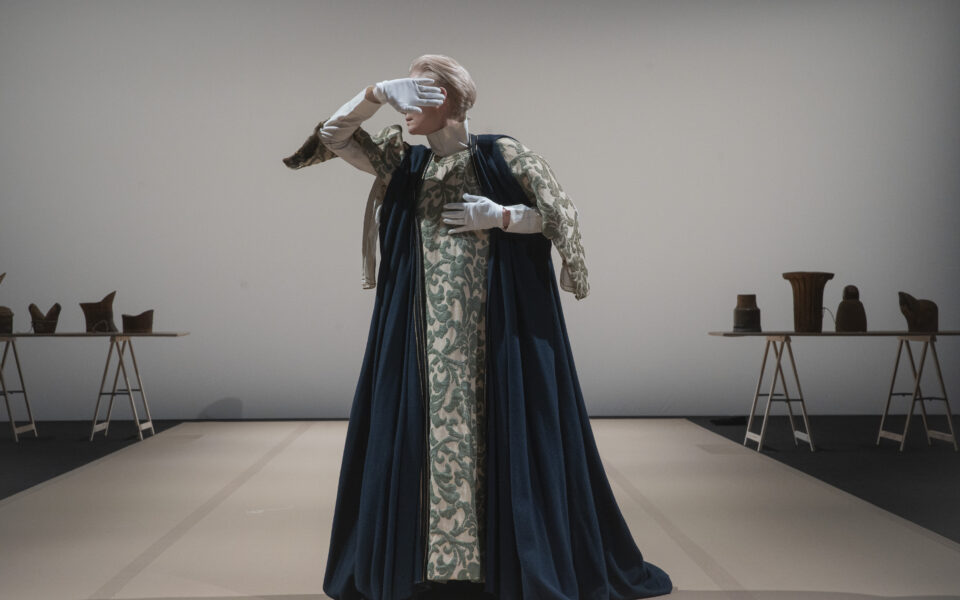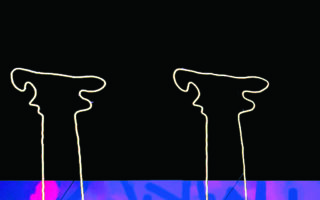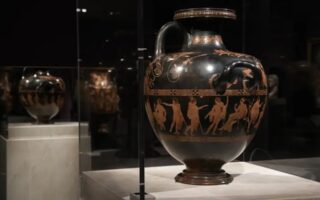Dressing roles and souls
Tilda Swinton stars in a performance paying homage to Pier Paolo Pasolini

Tilda Swinton was in stylish pink-brown shoes, not unlike those one would wear at home, when we encountered her Monday, about 14 hours after the “Embodying Pasolini” dress rehearsal at the Onassis Foundation Cultural Center, or Stegi, show room, one level bellow the ground floor.
She entered the small press briefing amphitheater with her very characteristic stride, almost gliding on the floor, not wishing to cause commotion – as if this were possible for a woman of such striking translucence.
“Our clothes are a choice we make to showcase our stance towards life at a particular point in time. Today I chose to wear these, probably due to the fact that I’m very tired and I wanted them to give me a sense of safety and strength,” she explained of her choice of footwear.
Sitting next to her in black pants, a denim shirt and lace-up shoes was fashion curator and historian Olivier Saillard, as the driving force behind the show, as her friend and companion in art, be it with realistic or fantastical outfits.
Both of wondered how best to describe “Embodying Pasolini.” Is it a performance, dance, theater or a concert due to the musical aspect of the show. Is it an artistic presentation, a cinematic homage?
“I like to live in the zone of the unexplainable,” Swinton commented.
At the epicenter of “Embodying Pasolini,” we find a modern artisan and a heretic, despite the fact that 100 years separate us from his birth. He bequeathed us with an incredible canon of films dedicated to analyzing myths, biblical stories and classic works of literature, from “Oedipus Rex” and “Medea” to “The Gospel According to St. Matthew” and “The Decameron,” and from “The Canterbury Tales” and “Arabian Nights” to “Pigsty.” In his films, everyday realism blends with the freedom of dreams, and nostalgia for the old world in a process that leaves us exposed and vulnerable in the face of the industrialized era.
In order to “dress up” his heroes’ vulnerability, Pasolini worked with costume designer and two-time Oscar winner Danilo Donati. Dozens of dresses with overcoats, produced with various experimental techniques, found themselves going from Donati’s hands into Pasolini’s movies. He would dye the threads on his own and even invented a machine to sew processed fabrics exactly as he wanted them. This humble, unremarkable sewing, with signs of imperfections, even wear and tear, encompasses the director’s ideas, and his ability to put the material on the big screen. The costumes are accompanied by wooden molds from Laboratorio Pieroni for hats that would later appear in the Italian director’s films.
“We’re still working on our material, we’re still looking for gold,” Swinton says, poignantly describing the hybrid way in which the performance is being created. Referring to the costumes that she adorned during this makeshift runway show, the Oscar-winning actress talks about “jewels,” “monuments,” “sculpted works of art” and “universal symbols.” She either puts them on or drapes them over her body and she walks wearing enormous hats, her stride flowing just as it would on the big screen.
As a pure-blooded big screen actress – having been in love with cinema for many years, she emphasized – she uses every millimeter of her face, which can be transformed from a grimace to a smile as fast as lightning. “I am constantly in search of honest, vivid movements,” she explains. She returns to an all-white canvas-like state with the same speed, as if she were challenging an artist to work on it.
When she’s not acting as a mannequin, Swinton turns on her androgynous side, moving silently, wearing perhaps three plain pieces of clothing. She opens up boxes, unwraps the dresses covered in protective layers of paper and unfolds them. She gazes upon them with love, caresses them, smells them, perhaps even tastes them. She chooses the narrative that will associatively transport us to Pasolini’s universe by looking back at the painting masters who inspired him: Giotto, Andrea Mantegna, Peter Bruegel.
“They are the stars; we just adorn them,” she says of the costumes.
One of the performance’s highlights – which will surely be different in every show – is the ritualistic unveiling of the dresses from “Salo, or 120 Days of Sodom.” Accompanied by a tender melody, evening gowns and hats are activated as prompts that immerse us in this brutal film. Last seen is the plain simple dress of a young girl, who is about to endure the sadism of the lords. Swinton carefully lays it on the box, covering it with paper as if it were a white sheet.
“Embodying Pasolini” is on stage through December 16 at the Onassis Cultural Center (onassis.org).





